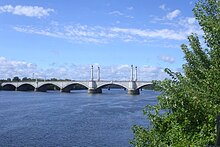West Springfield, Massachusetts
The settlers fled to higher ground on the east side of the river and founded Springfield in the aftermath of the great hurricane of 1635.
[8] Other than the trade in beaver skins, economic activity in early colonial Springfield consisted largely of subsistence farming and animal husbandry, with barter being the preferred medium of exchange for neighbors' crops, and locally produced goods.
[12] In many ways, the distinction between the church and the state in the early New England town form of government was fuzzy, though religious and secular meetings were held separately and generally led by different people.
On 29 May 1697, the Massachusetts General Court finally approved a separate parish and meeting house for the approximately 200 residents.
[19] Another dispute was immediately created when the charter of the town prevented it from taxing the property of Springfield residents within its boundaries.
[20] West Springfield minutemen participated in the American Revolutionary War beginning on April 20, 1775, the day after the Battles of Lexington and Concord.
[21] In 1777, a major contingent of Hessian and British troops were captured at the Battle of Saratoga and transported to Boston (for possible deportation or imprisonment).
The first North End Bridge opened 1887 with a sturdy metal box-shaped truss (the upper part of the box being suspended above the roadway).
Civil War-era dikes held back high water in the Agawam (Westfield) River in 1878, but heavy rain flooded the town again in 1927.
The New England Hurricane of 1938 flooded crops along Riverdale Road and severely damaged the Exposition grounds, causing the fair to close for the season.
It also opened a hole in the dike at Mosley Avenue, which was repaired before the rain waters could once again flood the lower section of town.
It damaged densely populated parts of West Springfield, causing two fatalities in the city—including a mother who died while shielding her 15-year-old daughter.
Agriculture continued to dominate the local economy when market gardening started in the 1830s, concentrating in the Riverdale Road area.
Growing population and improved transportation links increased the size of the potential market; by 1860, West Springfield was using greenhouses and exporting fresh crops to Boston.
Agriculture remained an important part of the West Springfield economy for many decades, but land development and economic changes led to a decline, and by the 1940s, it was a minor activity in the town.
[35] Light manufacturing began to grow in the 19th century, including tanned hides, horse carriages, gunpowder, ceramics, industrial pipes, hats, and boats.
[36] When the Industrial Revolution reached Western Massachusetts in the 19th century, the region's many fast-moving rivers resulted in a mill town boom.
Repair shops were also built in West Springfield in 1896,[40] and at the peak of operations, there were two major rail yards—one in Mittineague, and one near the present-day Memorial Avenue.
[43] Amtrak service is still available to Springfield, and the central rail yard is still in active use for freight by CSX, the present-day successor of this part of the Boston & Albany.
Rural Free Delivery started delivering postal mail to residents' homes in the late 19th or early 20th century.
A major power plant for the Western Massachusetts Electric Company (now a subsidiary of Northeast Utilities) went online in West Springfield in 1949.
They are part of the Metacomet Ridge, a mountainous trap rock ridgeline that stretches from Long Island Sound to nearly the Vermont border.
West Springfield is one of thirteen Massachusetts municipalities that have applied for, and been granted, city forms of government but wish to retain "The town of" in their official names.
The first town funds budgeted for police enforcement were in 1877; the force has gradually become professionalized, motorized, and equipped with and dedicated offices and jail facilities.
[80] The Department of Public Works provides water utility service to the town, drawing from four wells in the Great Brook section of Barne's Aquifer, in Southwick.
The well-water treatment plant (at 506 Shaker Road, Westfield,[83] on the Southwick border) uses 240,000 pounds of granular activated carbon to filter PFAS and the pesticides ethylene dibromide and dichloropropane from the well water.
[85] The city also has two interconnections (on Piper Road and Rogers Ave) with the Springfield Water and Sewer Commission for a backup supply, fed from Cobble Mountain Reservoir via a treatment facility in Westfield.
[84] West Springfield water tanks are located at 537 Rogers Ave, at the end of Goldenview Drive, and on Prospect Hill near 733 Bernie Ave. Semi-public "subscription" libraries operated from 1775 to 1807 and 1810–1840.
With easy access to the north–south Interstate 91, east–west Massachusetts Turnpike, and various freight railroads, West Springfield is sometimes called the "crossroads of New England".
The Riverdale Road corridor is a major regional shopping center, with a number of "big box" retail stores and car dealerships.








